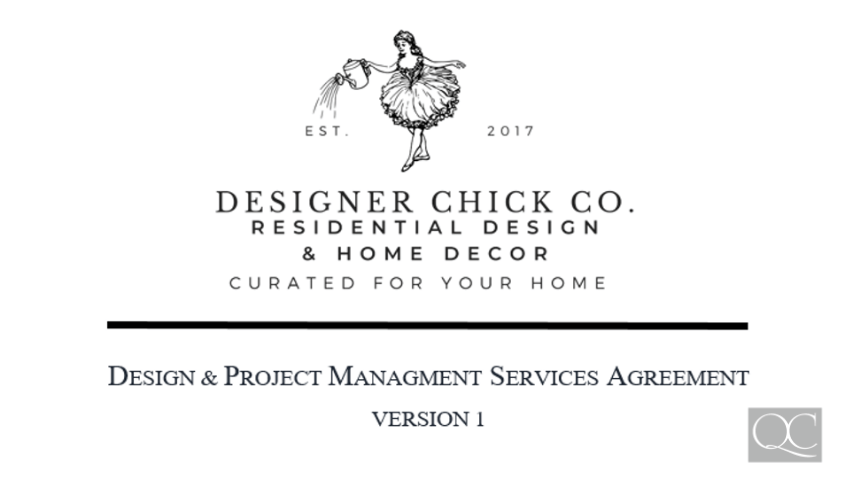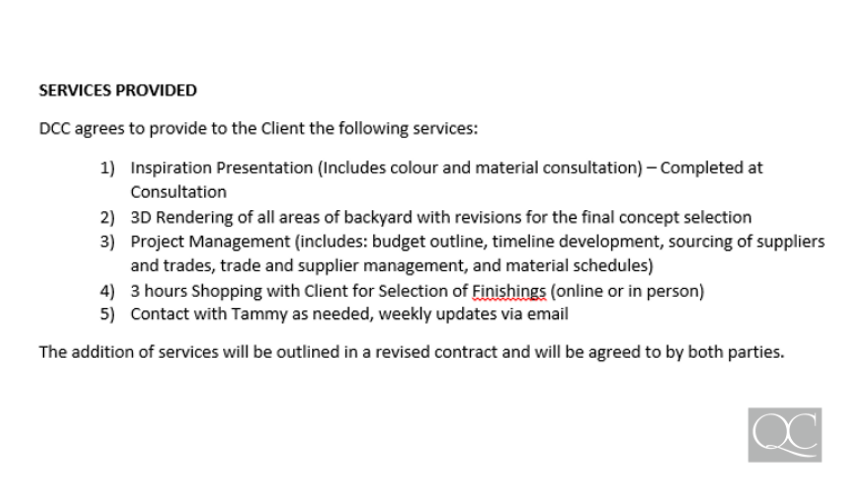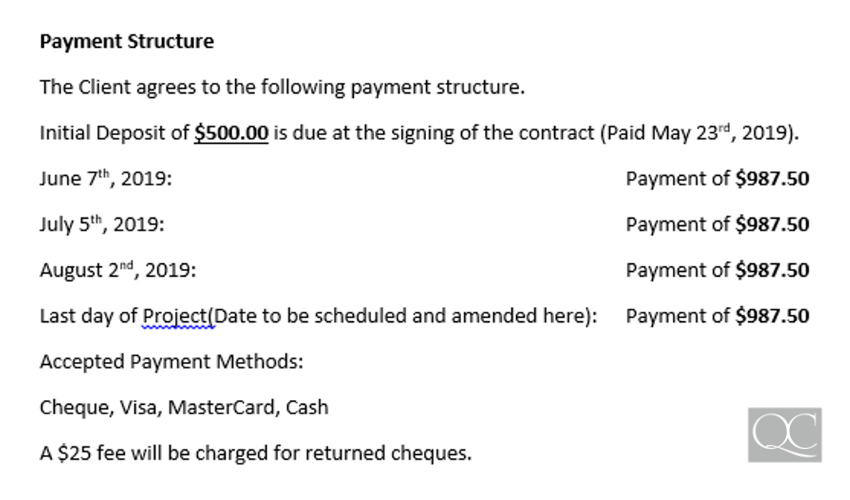Tammy Hart, I.D.D.P, CAPS is a graduate and tutor of QC Design School, as well as a Certified Aging in Place Specialist from the National Association of Home Builders. She is the owner and award-winning designer for the Designer Chick Co., and the Past Director on the National Board for DDA (formerly CDECA).
Tammy is a professional speaker at venues such as IIDEXCanada and the Small Business Forum. She’s been featured in East in the City Magazine, as a guest spot on Daytime Durham and Rogers TV, and has won the HOUZZ Service Award 2017.
Tammy places strong focus on working to empower young women to become successful future leaders, and is an advocate supporter of ocean clean-up efforts.
Whether you are (or want to be) an Interior Decorator, Color Consultant, Home Stager, Professional Organizer, Feng Shui expert, Aging in Place designer, etc., you’re going to NEED to know how to put together a business contract. Here, Tammy examines exactly why that’s so important, as well as what you need to have within your contract.
If you’re wondering how to become a designer, the following information will definitely set you up for success!

Why a Strong Contract is Essential
Given the environment and the impacts of the COVID-19 virus, it’s our responsibility as a society to maintain our social distance. Non-essential businesses will need to be closed. Over the next few weeks and/or months, you may find that YOUR business will be undoubtedly impacted.
Maybe your clients are cancelling out of fear of having strangers in their home. Perhaps it’s you that wants to protect both yourself and your team by limiting contact with others. Either way, now is a good time to discuss contracts, and the importance of having one.
I’m a firm believer that I do not lift a pencil until a contract has been signed. That is to say, no work will be started until a legal, binding negotiation has been put into place that all parties have agreed upon. This is because I want to first ensure several things:
- That the clients are on board with the project.
- I fully and properly understand their project.
- Pricing and pricing structure have been established.
- The clauses and justifiable circumstances that would warrant the termination of the contract have been clearly outlined.
It’s important to talk about contracts. But as I draw from personal experience with my own business contract (and the sections I feel are important to have in a contract), please keep in mind that everyone’s business functions differently.
As such, it’s imperative that you speak with a lawyer when drawing up your legal contract. This will help protect you and your business. At the end of the day, I’m a designer – not a lawyer.

Image provided by Tammy Hart.
Breaking Down a Solid Design Contract
As a professional designer, I take my contract with me to my first follow-up appointment (after the initial consultation with a client). Sure, maybe it’s presumptive. But doing this helps ensure that you ask for the sale, and open the lines of communication to start the project process.
When drawing up my contract, I start with the title page. On this, I list my business name, the project type, and the version number. At the bottom of the page, my business contact information is provided in the footer.
After this, I add my client’s contact information and the agreement date. Ensure that you have the correct spelling for all of the following information:
- The client’s name
- The client’s address
- The client’s contact information
- The date that the clients are expected to sign the contract
Next, I outline the responsibilities of both my company and the client. For example, I’m responsible for completing the project scope. The client, on the other hand, is responsible for paying for the project.
Then I break down and develop the following 3 sections:
- Initial Project Overview
- Scope of Work
- Timeline
#1 – Initial Project Overview
Under the Initial Project Overview, I outline the exact services I’m to provide the client. Then I outline the amount of work that the client’s project is going to include.
For example, I once managed a project for a backyard oasis. I outlined in the contract that, for my clients, our company would design and rebuild: 2 decks, the ground-level oasis, a 3-season room, HVAC, plumbing and electrical, fence repairs (as required), exterior lighting, and exterior fixtures.
We would also complete all the shopping for needed materials.

Image provided by Tammy Hart.
#2 – Scope of Work
After this, I move onto the Scope of Work. I break this section down and outline its various stages, which include:
- Asbuilts
- Preliminary Design
- Development Design
- Contractor Sourcing
- Budget Development
- Construction Drawings
- Construction
- Décor Installation
- Project Completion
These sections all explain what will have to happen in order to complete the project!
#3 – Timeline
Thirdly, I provide the client with the estimated length of time that each stage will take. This way, they’re realistically aware of how long every task will take, as well as the project overall.
Outlining the Budget
Next, you and your client need to talk about money. Based on the amount of work desired by the client, you can determine how much their budget will need to be to make it happen.
Maybe there will be an initial deposit that needs to be made at the beginning of the arrangement. Perhaps you’ll offer a payment structure that allows the client to pay off the remaining balance in increments, on a monthly or bi-monthly basis.
You can tailor this section accordingly, in a way that mutually benefits you and the client.
I start with the overall project fees. This is the total cost of the project. Then I break that number down into the ‘Payment Structure’, over the length of the project timeline. I also ensure to include any and all accepted payment methods, as well as potential charges for NSF (non-sufficient funds) fees.

Image provided by Tammy Hart.
Importantly, make sure that you add in any purchasing, supplying, and/or special ordering of décor, finishings, and furnishings that are needed for the project. These are the responsibilities of the client! How and when you wish to have this paid for is up to you, based on your comfort level.
For instance, I make my clients pay for special orders fully and upfront. I also don’t allow for cancellations on special orders.
Another critical part of the budget/cost section that your Design contract needs to discuss are ‘Additional Charges’. Examples of things that could incur additional charges include (but are not limited to):
- Disbursements
- Revision Allotments
- Contact Information
- Liability
- Arbitration
It’s exciting – but also scary – as you wait with anticipation for your client’s reaction to the cost. This is another reason why I like to present the contract in person. It allows me to gauge their reaction.
When the client first beholds the cost and structuring of the project, I watch out for large eyes, hard swallows, a sense of ease, etc. If there are any concerns, we can then discuss them immediately.
Cancellation Clauses and Policies
Finally, I make sure to incorporate my cancellation clauses, policies, and process into my Design contract. As a professional designer, this section is crucial for your contract in 2 very big ways.
Firstly, it protects your business in the event that the client terminates, suspends, or abandons the project. Likewise, this section also protects your client in the unlikely event that your company is the one terminating the contract.
Remember: at the end of the day, we’re all human! Though this is business, when it comes to the termination of a project, we need to consider ALL of the circumstances and possibilities. This is especially the case now, in light of the coronavirus pandemic.
Clients may not be working, and can no longer afford the project. Alternately, they may not want to take the risk of allowing strangers into their home.
Such situations may result in a delay, or the client terminating altogether. No matter the circumstances, don’t take this personally – even if the client is terminating because the professional relationship isn’t working. Instead, try to always take it as constructive feedback and a learning opportunity!

To Summarize…
Contracts are legal documents that outline the project, the parties involved, the budget, and the timeline. It protects both the business and the client by holding everyone accountable for their part to play.
As a designer, it’s important to ensure that you ALWAYS have a detailed contract between you and your client. On top of this, ensure that it’s always signed before beginning any work, no matter how big your client’s project may be.
Most importantly: just as a client seeks your professional guidance, so too must you seek the guidance of a lawyer to help you draw up your contract. Always make sure that you and your business are protected!



I think that you did a great job with providing information and also being especially thorough on this. I am only thirteen and this has really inspired me to follow through with my dream and be hopeful for a successful career in the far future!